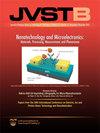Nanofabricating neural networks: Strategies, advances, and challenges
IF 1.4
4区 工程技术
引用次数: 3
Abstract
Nanofabrication can help us to emulate natural intelligence. Forward-engineering brain gained enormous momentum but still falls short in human neurodegenerative disease modeling. Here, organ-on-chip (OoC) implementation of tissue culture concepts in microfluidic formats already progressed with the identification of our knowledge gap in toxicology and drug metabolism studies. We believe that the self-organization of stem cells and chip technology is a key to advance such complex in vitro tissue models, including models of the human nervous system as envisaged in this review. However, current cultured networks of neurons show limited resemblance with the biological functions in the real nervous system or brain tissues. To take full advantage of scaling in the engineering domain of electron-, ion-, and photon beam technology and nanofabrication methods, more research is needed to meet the requirements of this specific field of chip technology applications. So far, surface topographies, microfluidics, and sensor and actuator integration concepts have all contributed to the patterning and control of neural network formation processes in vitro. However, when probing the state of the art for this type of miniaturized three-dimensional tissue models in PubMed, it was realized that there is very little systematic cross-disciplinary research with biomaterials originally formed for tissue engineering purposes translated to on-chip solutions for in vitro modeling. Therefore, this review contributes to the formulation of a sound design concept based on the understanding of the existing knowledge and the technical challenges toward finding better treatments and potential cures for devastating neurodegenerative diseases, like Parkinson's disease. Subsequently, an integration strategy based on a modular approach is proposed for nervous system-on-chip (NoC) models that can yield efficient and informative optical and electronic NoC readouts in validating and optimizing these conceptual choices in the innovative process of a fast growing and exciting new OoC industry.纳米制造神经网络:策略、进展和挑战
纳米制造可以帮助我们模拟自然智能。前瞻脑工程获得了巨大的发展势头,但在人类神经退行性疾病建模方面仍存在不足。在这里,随着我们在毒理学和药物代谢研究方面的知识差距的确定,微流控格式的组织培养概念的器官芯片(OoC)实施已经取得了进展。我们相信干细胞的自组织和芯片技术是推进这种复杂的体外组织模型的关键,包括本综述所设想的人类神经系统模型。然而,目前培养的神经元网络与真实神经系统或脑组织的生物学功能的相似性有限。为了充分利用电子束、离子束和光子束技术和纳米制造方法在工程领域的缩放优势,需要进行更多的研究来满足这一特定领域的芯片技术应用要求。到目前为止,表面形貌、微流体、传感器和执行器集成的概念都有助于体外神经网络形成过程的模式和控制。然而,当在PubMed中探索这种类型的小型化三维组织模型的最新技术时,人们意识到,很少有系统的跨学科研究,将最初为组织工程目的形成的生物材料转化为芯片上的体外建模解决方案。因此,这篇综述有助于在了解现有知识和技术挑战的基础上,制定一个合理的设计概念,以寻找更好的治疗方法和潜在的治愈破坏性神经退行性疾病,如帕金森病。随后,提出了一种基于模块化方法的集成策略,用于神经系统芯片(NoC)模型,该模型可以在快速增长和令人兴奋的新兴OoC行业的创新过程中验证和优化这些概念选择,从而产生高效且信息丰富的光学和电子NoC读数。
本文章由计算机程序翻译,如有差异,请以英文原文为准。
求助全文
约1分钟内获得全文
求助全文
来源期刊

Journal of Vacuum Science & Technology B
工程技术-工程:电子与电气
自引率
14.30%
发文量
0
审稿时长
2.5 months
期刊介绍:
Journal of Vacuum Science & Technology B emphasizes processing, measurement and phenomena associated with micrometer and nanometer structures and devices. Processing may include vacuum processing, plasma processing and microlithography among others, while measurement refers to a wide range of materials and device characterization methods for understanding the physics and chemistry of submicron and nanometer structures and devices.
 求助内容:
求助内容: 应助结果提醒方式:
应助结果提醒方式:


